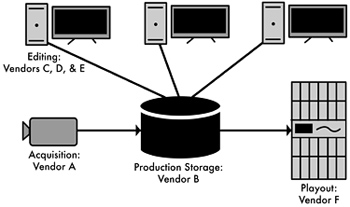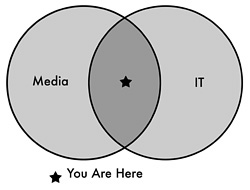Don't Worry, Be Happy!

It seems these days that a lot of people are worried about a lot of things. Despite popular perception, I think there is really very little to worry about. Things are never as bad as they seem—or as good as they seem for that matter. We humans have a strong tendency to exaggerate both the good and the bad.
Benjamin Franklin said, "Do not anticipate trouble or worry about what may never happen. Keep in the sunlight."
An example of this is the worry that many vendors of broadcast technology products have about the impact of Service-Oriented Architecture on them. They express a lot of concerns about how to realign their products to this approach.
COMMODITIZATION

Fig. 1: Multivendor editing is on the rise Probably the greatest concern is the creeping commoditization of their type of product. They have seen commoditization occur for other reasons, like in nonlinear editing to some degree, (see Fig. 1), and see SOA as accelerating these trends. By breaking down complexity into simpler services, it makes it easier to swap out one vendor for another or use a mixed vendor environment. This is a key advantage of SOA—separating interface from implementation.
On some level, there really is validity to this concern. I would argue, however, that in cases where this could happen, it would likely happen anyway. A customer who wishes to swap out one product for another or use a mixture of products will usually find a way to do it. Making it somewhat more difficult because of tightly coupled interfaces is not going to be the deciding factor in favor of maintaining only the vendor's products.
Additionally, by adopting a services based approach in their product, vendors are gaining many advantages. If they truly have a "best-in-class" product, then customers will be more attracted to their product because of ease of integration in a SOA environment. They will be more likely to supplant their competitors.
They are also not spending valuable time doing things which are not core to their business model. Very few vendors in this space can truly make a profit interfacing to other products. This is one reason the automation space struggles so much. It is far better for a vendor to deploy valuable engineering resources improving the core functionality of their product. When this is done, everybody wins!
GETTING STARTED
Another concern is with how to get started. Some vendors in our space have a lot of products, and some, only one or a few. The answer is to start with those products for which the vendor is investing the most in creating interfaces to other products. This is where they will get the biggest bang for their buck. For those with many products that have been gathered through acquisition, adopting SOA might be the best way to get their own products working together.
Some are concerned about the impact on their support organizations. This is the least valid concern. Adopting SOA should reduce support issues for vendors. As there is only one interface to be concerned with, complexity is greatly reduced. Also, as these interfaces are now defined at the business level, it is often easier to determine the source of issues that may arise.

Fig. 2: Potential support models for a vendor An interesting concern is how to approach a vendor's commercial model when they adopt a services model. How should they price individual services? How do they incorporate hardware in the commercial model? Should some services be bundled and packaged? There is no easy answer to these questions and the answers will depend in part on the nature of the technology. But I think there is a real likelihood that vendors would receive an improved return on their investment in R&D dollars. Taking a services approach enables greater focus of that investment on what provides the greatest value.
And there are new commercial opportunities perhaps, (see Fig. 2). By going down a services path, there is a possibility of moving up the "value chain" as a vendor. In addition to the traditional support models shown in Option A, the vendor can now supply support at the services layer and the integration of a service into a process as shown in Option B. It is also possible to begin to engage in business process consulting as seen in Option C. Process and service outsourcing can be considered. In actuality, the possibilities are endless.
Indian spiritual leader Meher Baba said, "Don't worry, be happy." Adopting SOA may seem like a risky step to some vendors, but if they do move in that direction, everybody wins. You can Count on IT!
John Footen is a vice president at National TeleConsultants and the head of its Software Solutions Group. He is also co-author of the book, "Service-Oriented Media Enterprise." He can be reached atjfooten@ntc.com.
Get the TV Tech Newsletter
The professional video industry's #1 source for news, trends and product and tech information. Sign up below.
With more than three decades of M&E experience under his belt, John Footen is a managing director who leads Deloitte Consulting LLP’s media technology and operations practice. He has been a chairperson for various industry technology committees. He earned the SMPTE Medal for Workflow Systems and became a Fellow of SMPTE. He also co-authored a book, called “The Service-Oriented Media Enterprise: SOA, BPM, and Web Services in Professional Media Systems,” and has published many articles in industry publications.

